How to Build an MVP: Guide for 2022
19 min read
Page Content
- 1. What is a Minimum Viable Product?
- 2. The Examples of Successful MVP
- 3. Benefits from Developing an MVP
- 4. Challenges You May Faced When Create a Minimum Viable Product
- 5. Define If You Need to Develop a Minimum Viable Product
- 6. Tech Stack Needed to Make an MVP
- 7. 7 Steps to Build an MVP
- 8. How Much Does It Cost to Build a Minimum Viable Product?
- 9. Next Steps After Building an MVP
- 10. Our Experience in Creating a Minimum Viable Product
- 11. Conclusion
What is a minimum viable product, what does it give, do you need to develop it, and if so, how and where to start? Learn more and find out what challenges the product owners are facing and how to deal with them.
What is a Minimum Viable Product?
 The idea of Launching an mvp is very popular for most product owners these days. The name itself stands for a minimum viable product, and it is essentially a working version of a product with minimal functionality. It is designed to perform the following functions:
The idea of Launching an mvp is very popular for most product owners these days. The name itself stands for a minimum viable product, and it is essentially a working version of a product with minimal functionality. It is designed to perform the following functions:
- Attracting the first potential customers;
- Getting feedback to improve the future product;
- In addition, it gives a rough idea of the product, which will help attract investors.
The concept of MVP appeared relatively recently - in 2001. It was written by Frank Robinson, president of the SyncDev consulting company.
Robinson perceived the minimum viable product as a product of simultaneous project development and target audience learning, receiving feedback from the end-user.
The most widely known MVP is due to Steve Blank and Eric Rees - American entrepreneurs, adherents of the idea of “Lean Startup”.
Be careful not to confuse it with the prototype: MVP should not be a “crude” and primitive version; it should have the most basic functions implemented as professionally and efficiently as possible.
The Examples of Successful MVP
Many of the currently well-known and highly demanded products have also passed the MVP stage. Among them, by the way, is one of the most popular social networks nowadays - Facebook. However, most likely everyone knows this example. But here are a couple more rarely mentioned:
Spotify
It is a music streaming service. It is a perfect example that sometimes the most minimal function can be enough for a resounding success.
The Spotify founders implemented an MVP representing the desktop version of the app and launched it in closed beta.

Their main task was to test how viable the idea was. After testing and getting the first positive feedback on the service, its creators developed the application and signed new music artists. As a result, the use of MVP allowed them to significantly reduce development and product launch costs.
Foursquare
It’s a Local social platform for tourists, where you can find a place to stay, leave a review, see the ratings of other visitors.
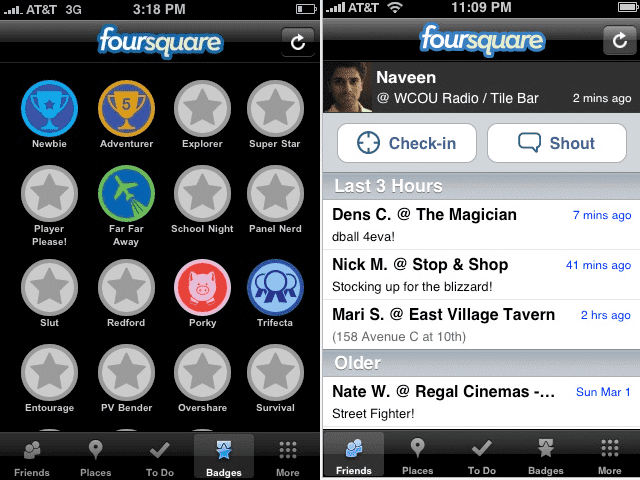
This service is a great example of an MVP product with one key function. In the initial MVP version of this service, users could only register in different places to receive a reward. After making sure of the success of the potential product, its creators decided to add additional functions. Thus, the Foursquare appeared in the form that is well known now.
The world-famous social network began as an application where people could share experiences and tag friends in different places. Its original name was Burbn.
After launching MVP and collecting the first feedback, it turned out that the product was overloaded with functions and inconvenient, hard understandable for users.
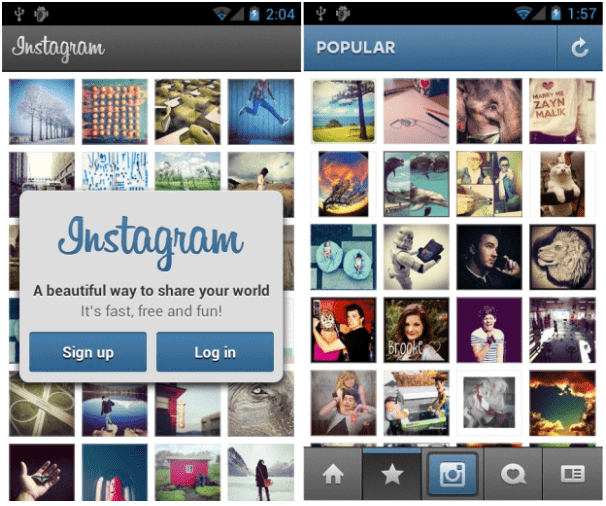
But what came out great was the quick photo sharing feature. Based on its success, the app has continued its journey to millions of active users and worldwide fame.
Dropbox
It is a cloud storage startup. Initially knowing about the strong competition in this niche and a huge amount of similar software, product founders decided to create a video tutorial on how to use the application.
It received wide publicity and became the basis for future product development.
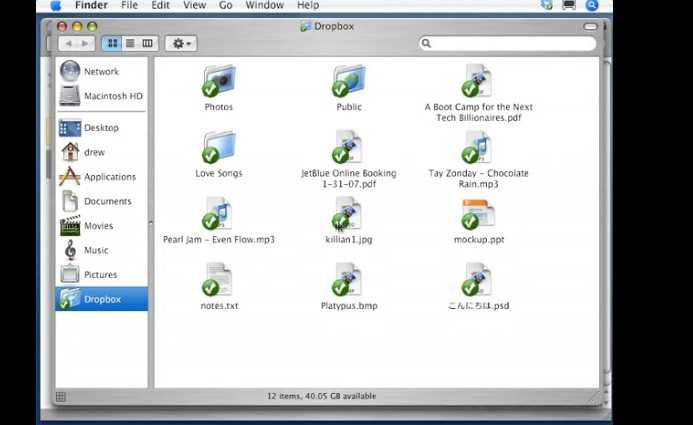
After the launch, the minimum viable product received tens of thousands of emails from potential users, which contributed to the further expansion and scaling of the project.
Want to create a profitable MVP, but don't know where to start?
Ask all the necessary questions to our specialists and get high-quality consulting absolutely free of charge!
Contact UsBenefits from Developing an MVP
Let’s look more specifically at the advantages that building an MVP gives to a product owner.
Formation of an accurate hypothesis of product development
By getting feedback from users, you can more easily determine which features will succeed, which ones should be removed, and which ones should be improved. This makes it much easier to work on features and gives a more or less accurate forecast of product demand, helping to avoid risks and financial losses.
Fast intermediate result
Make a minimum viable product is much faster than develop full-fledged software. That is, you spend a minimum of time and quickly get a viable version of the product, get the first income, reviews, and know what to work with and how to continue.
Cutting costs
Minimum Viable Product implies a minimum set of features. Accordingly, there is no need to implement complex features. Accordingly, for such a task, you will need fewer developers and working hours.
Attracting investments
Finally, creating a minimum viable product helps attract investors. Before investing money in a product, investors prefer to get at least a rough idea of it, as well as get acquainted with the development prospects. All this confirms the potential success of the project, and it’s easy to achieve with MVP.
Challenges You May Faced When Create a Minimum Viable Product
Misidentification of user’s needs
Unfortunately, even the most perfect and brilliant idea is doomed to fail if you misidentify the needs of your target audience.
Before embarking on the development, conduct an analysis of a potential consumer. Answer yourself 2 main questions:
- Do users really need this product?
- What problems will it help them solve and how?
The answers will help you understand how to create a minimum viable product with a clear sales goal. When defining a potential end-user, try to do it as accurately as possible: age, profession, level of education and income, hobbies, and behavioral models - all this is important because it helps you better adapt the project to their expectations, make the software as convenient and useful as possible.
Underestimating competition
You can be sure of the uniqueness of the project and discard the problem of competition. But in the current market, there is such a huge variety of products that most likely your potential end-users are already using a similar solution. Then why would they use yours instead? And here we come to an important understanding: it is not enough just to launch a website/application. How to build an mvp that will be a cut above the competition in terms of quality and efficiency?
So, to find opportunities to provide the best service, analyze your competitors, test their product, if possible. Ask what problems competing products have so you know where they can be surpassed. Thus, thanks to this method, you will be able to determine exactly in which direction to improve your product.
Unsuitable methodology
The two most popular software development management methodologies in the world are Waterfall and Agile.
With any methodology, work is done with milestones, but in the case of using Waterfall, all sprints are planned before the start of development, they are fixed and not changeable.
In the case of Agile, the next sprint is planned only when the previous is closed and analyzed. So, you always remain aware of all the processes, can correct them depending on the problems and nuances that arise almost immediately.
From our side, we recommend you to work with Agile methodology, especially when it comes to a startup when it is very important to design an mvp easily changeable and able to improve “on the fly” - in order to respond to customer feedback as quickly as possible. To achieve this effect, it is necessary to use interactive development methods such as Lean, Scrum, Kanban, and extreme programming. These methods will help you update your product regularly, quickly, and consistently.
Inexperienced team
Choose the right development company for a startup is a challenge in itself.
When making a choice, check potential technical partners carefully:
- Services like a Clutch, where you can select a remote team using a variety of filters and evaluate the company with an open mind;
- Check out the portfolio - the more successfully completed projects are already in the company’s luggage, the more likely your own enterprise will be successful;
- Get acquainted with ready-made products implemented by this team, read customer reviews - all this will give an approximate understanding of the specifics of cooperation with this technical partner;
- Pay attention to pricing policy: skilled teams can’t provide development services for cheap. But this doesn’t mean that you have to overpay. Professional companies are likely to offer several financing options and will be able to justify their price tag reasonably.
Define If You Need to Develop a Minimum Viable Product
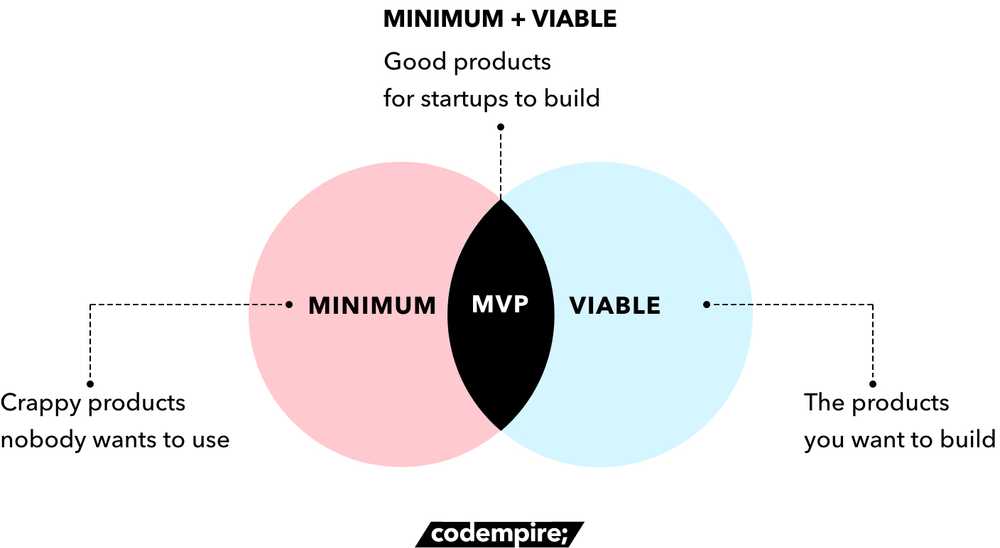
Launch an mvp is an excellent solution for a project, both for startups and a product of a large experienced organization.
But, like any solution, it may not be appropriate and necessary under all circumstances and for any solution.
Let’s consider the situations when MVP is a must:
- It’s about a startup, and you have a lack of experience and do not have a large loyal audience of potential customers. Here MVP will help you collect the first users and get actual feedback;
- Your product is experimental, new on the market, and has no analogs. With MVP, it will be easier for you to understand whether you have determined the pains of users, whether they have solved their problems and how much they need such a product at all;
- On the contrary - your project is from an area with strong competition and a huge number of similar solutions. Then the minimum viable product will highlight the moments where you can bypass competitors by providing a more user-friendly service;
- You are planning a large project with a high volume budget that is complex and time-consuming to implement. Then MVP will help you anticipate possible shortcomings and reduce financial risks.
In what situations can you do without an MVP production?
- If you are an experienced entrepreneur, confident in a thorough knowledge of your business niche, who have foreseen and calculated all possible risks;
- In situations where it is impractical to carry out multiple functionality revisions and continuously make changes to the project.
- When there is no need to pay significant attention to small, frequent product updates;
- If there is no opportunity or need to collect and process user feedback.
As a rule, these factors are typical for projects related to the automation of processes in large-scale military, government and factory enterprises. Where there are clear requirements, there is no need for experimentation and feature testing.
Need more specific information for a startup idea?
Let's conduct a call - our experts will provide digital consulting, market analysis, and preliminary evaluation of your future software.
Contact UsTech Stack Needed to Make an MVP
Choosing the right tech stack is extremely important when you plan an mvp. How much time and money will be spent on implementation, and how easy it will be to scale and change the finished project in the future - all these depend on the right choice of technologies.
Before choosing technologies, decide on the type of software.
Conduct an analysis of potential users in your region, find out what they are more willing to use: a mobile application or websites, which platforms are more popular.
Work out your business strategy to understand which software will help you achieve your goal more efficiently. For example, a marketing website can be a good tool to attract first buyers or to announce a product launch on the market; and for a fitness product, it would be better to use a mobile application - so that users can conveniently use it wherever they are.
Let’s take a closer look at what technologies and tools are best used for different parts of the development process.
Database
There are 2 types of databases - Relational and non-relational.
An example of the first type is PostgreSQL. It is best used for projects where there is a need for data security - for example, healthcare products that involve working with personal data and confidentiality. The second type is faster and more flexible in work. It is best used for software such as food delivery applications - where there is no need for extra security. An example of such a database with which we work is MongoDB.
Backend
For startups and MVP, we recommend using Node.js with the Nest.js framework - with them you can win in speed and quality because they provide a quick start to develop due to their flexibility and non-overload.
But if you are dealing with an enterprise-level product - like large-scale projects for space science programs - it would be better to choose the .net C# stack or Java with Spring framework.
Cloud system
We recommend using AWS - the largest cloud system, with 1000 different services, capable of covering any task. In addition, this platform provides support for startups using a special program. So, by registering and participating in the program, you can get a free annual hosting plan for your startup.
Frontend
We recommend choosing to React for web development and React Native for mobile app development.
This technology offers undeniable advantages.
Firstly, it is very popular. This means there will be good support from the community, it will be easier for you to find really pro specialists.
Secondly, it’s much more fast and flexible compared to Angular.
Mobile development
You can use native development, but you ought to hire either two different teams, or one expensive one, to develop a product for iOS and Android, investing a lot of money and time. In addition, parallel development often runs into a problem when the development of one version lags behind the development of another.
Alternatively, you can use React Native, which will significantly save budget and time: since this technology makes hybrid development possible, you don’t need to hire two different teams.
Thus, your product is developed by one team simultaneously for several platforms at once and you don’t have to skimp on quality.
Analytics
When launching a product - regardless of its type, scale, and tech stack - it is necessary to use analytics on an ongoing basis. Services like Google Analytics, Segment.io will be a good solution.
By recording data about site visits, user experience, the popularity of app features, target audience analysis, etc., these tools will make your build-measure-learn cycle more effective.
7 Steps to Build an MVP
As in any business, you need a sequence and a certain algorithm of actions. Here are the basic steps to build an mvp.
1. Define the concept
Before implementing a business idea, you should decide on its main concept, prepare documentation with approximate requirements and features of the future product, and make a rough idea of it.
2. Do a market research
Explore the niche in which you want to develop your software. Analyze the features, topical issues, and development trends. Collect competitor data. Especially if there are many solutions on the market like yours, this will help you create a solution that is superior to the existing ones.
To gather the information you need, you can use special services that provide data on-site traffic, the geography of interaction, profitable keywords, etc. Among the most popular, we want to note such as:
3. Determining the flow of users
This is a sequence of actions taken by a prospective client in an application/website until the desired result is obtained. It is best to make this path as short, simple, and comfortable as possible. Moreover, at each stage of this algorithm, it is necessary to define its own must-have function, which ensures the most effective interaction with the end-user.
And here we come to the meaning of defining user flow, which is the next step.
4. Define core functions and prioritize
You should start with functions directly related to the main purpose of constructing an MVP. Hold off on adding more complex additional features at the first stages of development - to ensure the reliability of the information received from the first customers.
After that, you can start looking for a technical partner.

It is very important to find an expert team that has the necessary knowledge and experience to develop a minimum viable product.
Consider the portfolio of candidates, read reviews, and information about their completed projects. You can check the finished products yourself.
5. Create UI prototype
After you’ve done your market research, you have to substantiate your idea before moving on to the development phase. One of the most cost-effective and time-efficient ways is to validate a project idea with the prototype before you develop an mvp. This way you will see how your future product will look like.
6. Development itself
Stay in touch with the development team, make regular calls and demos, and make adjustments to the MVP establishment process if needed. At this stage, perhaps, the competence of the partner company and the quality of service become visible the most.
7. Testing
It is very valuable here to test the product during all steps of development. This will allow you to get the most accurate data from users (actually what all this work began for), not distorted by technical errors made due to a lack of understanding of how to properly test MVP.
And now I mean not only alpha testing, which is done by QA engineers within the team; but also beta testing, for which you will need people outside the team.
You can find willing candidates on such resources as BetaList, ProductHunt, Reddit, Quora; and you can also involve social networks, email newsletters, and blogs.
Get market analysis for free
Our experts will consider your idea, determine the target audience, analyze the market and provide you with a preliminary estimate - just contact us!
Contact UsHow Much Does It Cost to Build a Minimum Viable Product?
Although an MVP is the initial version of a product with a minimal set of features, the cost of minimum viable product development is not drastically different from the cost of a full-blown app.
If we talk about numbers, then the average price will vary from $15000 to $50000.
If we talk about the main pricing factors, then the cost of your product depends on:
- Chosen technology stack;
- Models of cooperation with a partner company (fixed price or hourly rate, etc.);
- Features of the contract (terms, work of engineers, etc.);
- Naturally, the amount of work - how complex the solution is, how long it will take to implement it;
- Peculiarities of marketing strategy, etc.
As you can see, there can be many nuances that affect the price. It is best, of course, to get preliminary advice from an expert team, where your idea will be considered in more detail.
Сalculate the cost of your project
Just contact us - and our specialists will calculate the approximate development price for you for free, according to the scale and parameters of your project.
Contact UsNext Steps After Building an MVP
1. Launch&promotion
Even the most sophisticated product can fail if promotion issues are underestimated.
You should initially take into account marketing funding and develop a promotion strategy in advance.
This way you can reach the maximum number of potential customers. Firstly, it will increase monetization, and secondly, it will make collecting feedback more efficient and faster.
The finance app Mint is a prime example of successful marketing. The product owner launched the promotion as soon as the MVP entered the market. They leveraged the blog and gathered their first customers using an email sign-up form. As a result, in 2 years of existence, the application received its first million users.
2. Set the price
Often product owners spin out a pricing issue, and many of them think that MVP monetization should be minimal. However, it is important not to forget that MVP is not a crude, unfinished or incomplete version of a product, but a ready-made solution that already covers the basic needs of the end-user. This means that it should have an appropriate price.
Pay more attention to this issue: market analysis results, and feedback from customers, and competitor analysis will be useful to you here.
3. Build, Measure, Learn
Now you have already completed the development phase, successfully launched the product. But the process of developing an mvp doesn’t end there.
Next comes the Build-Measure-Learn cycle.
What does it mean?
After the project becomes available to end-users, you do not stop testing and collecting feedback. This is the Measure stage.
The information received is the basis for the further development of the product: depending on the customers’ request, you make decisions on changing the design, adjusting the existing functionality, or adding new features, etc. This is the Learn stage.
Then comes the Build stage, during which these changes are implemented.
Then you repeat this cycle, gradually improving the product to get the most user-friendly solution and conquer the market by beating the competition.
Get Free Evaluation From Pro Experts
Our specialists will form a preliminary estimate, analyze the market, and target audience, answer all questions about how to develop an MVP - just write us!
Contact UsOur Experience in Creating a Minimum Viable Product
Almost all projects we worked on started with MVP production.
Here are some examples of successfully implemented products:
Avid Adventures
Our client - Avid Adventures - is a company from Malaysia, whose main specialization is the creation of educational software for children.
They came to us with design and requirement documentation.
The initial task was to create a mobile application - a career development simulation game.
However, the deadlines were minimal - only 3 months to create an MVP. Accordingly, we needed to reduce the implementation time as much as possible and validate the project on time.
Therefore, it was decided to develop a Progressive Web Application - essentially a website, but functioning as an application and having an appropriate interface.
So, the customer did not need to spend time publishing in the App Store and Google Play, and we were able to meet the deadlines.
Thanks to powerful servers and a well-thought-out tech stack, the application ensures smooth online work with huge audiences of players.
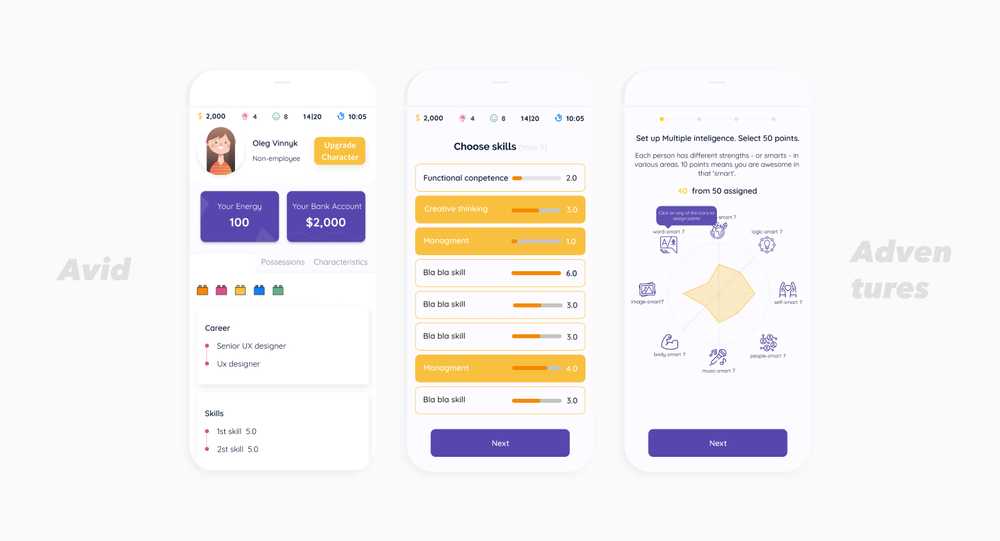
Now this project is successfully expanding and gaining more and more clients around the world.
Suzie
Our clients are a startup from London, UK. They came to us with the idea to create an application that functionally resembles the well-known booking service Booking.com.
The main task was to develop a solution for convenient hotel booking, buying air tickets, and navigating through the hotels. But in addition, it was necessary to provide users with the opportunity to communicate with other tourists, as well as see who of them stayed in the same hotel.
As a result, our specialists were able to develop a service with which you can make a hotel reservation in 3 clicks; customize your filter search to find the best deals from airlines and hotels, and plan your trip perfectly.
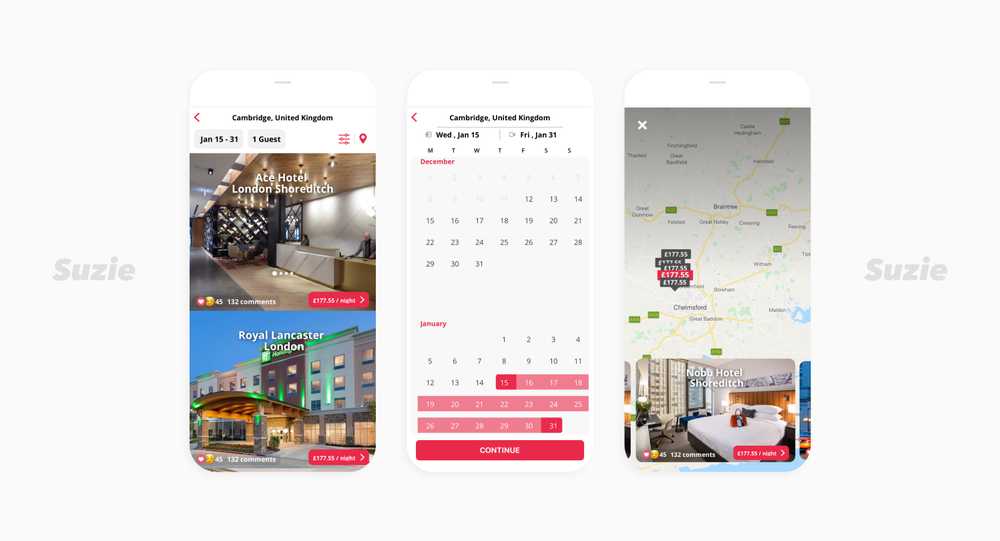
The communication function between users was implemented according to the Tinder principle: participants put mutual likes to each other, after which they can chat, get to know each other, and share useful information.
And in order to provide 24/7 support for users, we have developed a chatbot that automatically gives advice on any issues.
IncidentGo
Our client is a security agency from New York. Their business idea was to create an application to improve communication between the security service and their clients - commercial companies, universities, etc.
The main principle of the future product from the end-user side was to provide the client with the ability to transmit their GPS coordinates to the security center or to the 911 service in case of emergencies.
In addition, there should be an emergency button in the application - to instantly call the rescue service/police patrol/fire brigade and other services.
As for the functionality for the security service employees, our task was to equip the product with a digital card indicating new incidents in real-time. So, security personnel can react in a timely manner and send help.
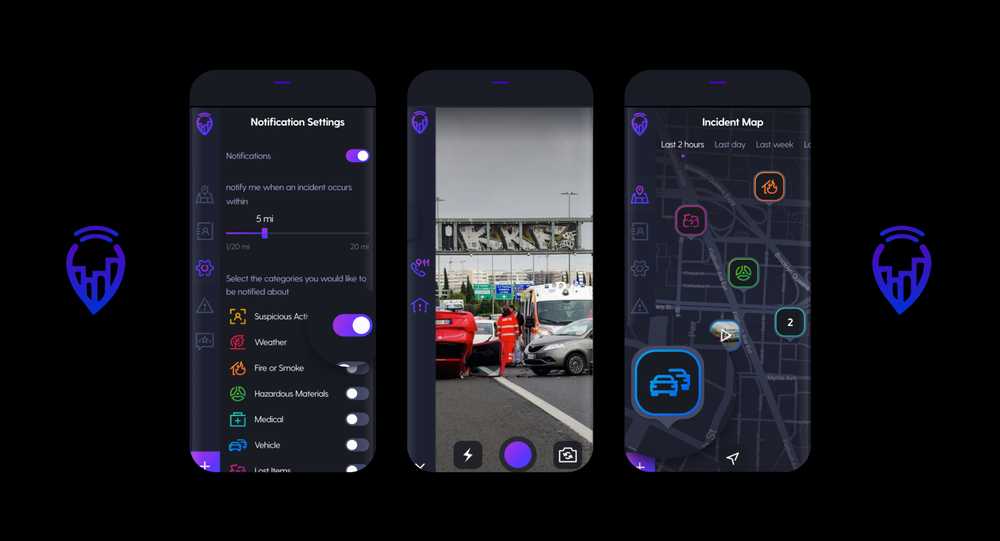
As a result, our engineers have developed an IOS and Android app with a real-time GPS tracking function.
It was equipped with a chatbot to provide people with instructions on how to behave in emergencies, the ability to share photos and videos, and an alarm button.
The interface includes 2 parts: a digital map with incident indicators, and a list of incidents.
Thanks to our professionally built technical stack, the client saved about 30% of the budget and implementation time.
At the moment, the software is already successfully working, serving several security agencies and preventing incidents.
As you can see, we dealt with various challenges, technologies, project features, and different business niches.
Therefore, you can rest assured of the expertise of our specialists and the high quality of our web development services.
Conclusion
So, you already know what a minimum viable product is, how to test it, and how to work with it.
By the time you collect user feedback, you will already be able to understand exactly whether product development is appropriate, whether it is capable to solve the tasks, and where it should be improved.
That being said, you don’t have to spend a lot of money and hire a lot of specialists at the risk of failure and loss.
As a result, you get the MVP of the future product, you already have enough experience and information to expand your business idea into a large project, and you already have the first loyal customers, investors, and vectors for further development.
#startup
#MVP